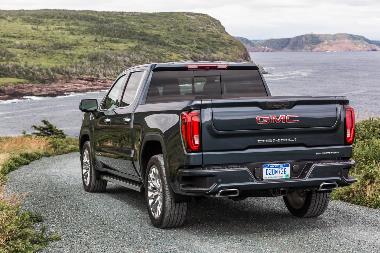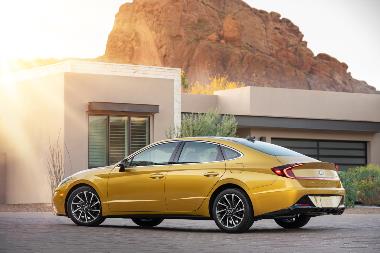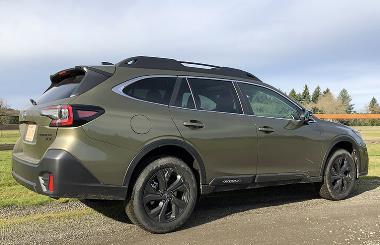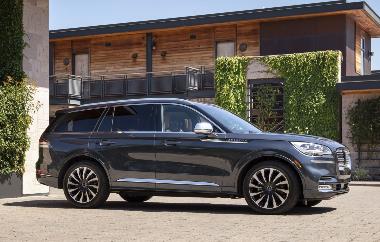-

2020 GMC Sierra 1500 Denali: More Tech, Lots of Cameras and a Carbon-fiber Bed
Tuesday, May 26, 2020
When General Motors began the GMC truck line in 1912, it stood on its own as a durable work truck. Over the next century, GMC seemed to be a Chevy …
Show MoreWhen General Motors began the GMC truck line in 1912, it stood on its own as a durable work truck. Over the next century, GMC seemed to be a Chevy truck clone with different trims, power and pricing variances. Building its own rep that included a perception of extra strength and ruggedness, GMC has sought to distance itself further from its Bow-tie sibling. With the 2020 GMC Sierra, the truck badge differentiates itself from its sister, the Chevrolet Silverado, with exclusive features and five engine options.
Mechanically, a Silverado twin, Sierra’s carbon-fiber bed option, six-function Multi-Pro Tailgate, and new Enhanced ProGrade Trailering System with 15 cameras, help give Sierra its own personality.
New for 2020, the Sierra Denali trim gets a 10-speed automatic transmission, up from an 8-speed last year. The new industry-first Carbon-fiber cargo box is available and was developed to increase durability, efficiency and functionality, while offering best-in-class dent, scratch and corrosion resistance. New features include adaptive cruise control, trailer tow mirrors, HD Surround Vision with two trailer camera provisions, and a trailer-tow bed-view camera system.
Sierra 1500 offerings include 6 trims, regular cab, double cab and crew cab body styles — all offered with 2WD or 4WD, and various box configurations.
Built for lightness with a mixed materials approach — including aluminum for the doors, hood and tailgate, with steel for the fenders, roof and standard cargo box, each of Sierra’s trims have styling nuances. I tested the top-of-the line Sierra Denali, distinguished by iconic design cues, a tall, strong, purposeful stance, accented by bold bodywork, chiseled shoulders and a tall, powerful hood, capped with a grille that’s big and bold.
The Sierra 1500 trims are muscular and versatile in three cab styles. Sierra’s length runs from 229.6 inches with a regular cab and 8-foot box, to 231.7 inches with either a double cab and 6-6 box or the crew cab and a 5-foot-8 box. The Crew and 6-foot-6-inch box is 241.3 inches long. The Sierra Denali I tested, with crew cab and short box, sat on a 147.4-inch wheelbase (regular cab models are on a 157-inch wheelbase). Width goes 81.2 inches and height is 75.5 inches. Curbweight for the 4WD short-box Sierra Denali Crew Cab is a robust 5040 lbs. (regular cabs go as low as 4520), and the max trailering rate is 12,200 lbs
GMC offers an engine for every taste … five of them -- 4.3-liter V-6, 5.3-liter V-8, 2.7-liter turbo, 6.2-liter V-8 or a 3.0-liter turbo-diesel. Fuel economy runs from 15 to 23mpg in city driving and from 19 to 26 mpg on the highway. Powerwise, the 4.3 gets you 285hp and 305 lb-ft; the 5.3 rates at 355hp/383 lb-ft; the 2.7 turbo runs 310hp/348lb-ft; the 6.2 delivers 420hp/460 lb-ft. and the 3.0-liter I-6 turbo pops 277hp/460 lb-ft.
My 6.2-liter Sierra Denali was an upgrade over the standard 5.3 and was rated at 15mpg/city and 20mpg/highway -- I averaged 18.0 mpg in my heavy-footed tests, and I pedal mashed often, with power answering when called. Handling was floaty and big-trucklike, and steering was a bit vague, but power was never in question. The 6.2 responded with a 6.1-second zero-to-60mph dash, and a 15.5-second quarter-mile, with excellent passing power and hesitant low-range response in town. The independent front suspension with coil-over-shock and twin-tube shock absorbers works well with the solid axle rear with semi-elliptic, variable-rate, two-stage multileaf springs, and splayed twin-tube shocks to glide over road ruts, but there is some float at speed and sway in quick turns.
Inside, Sierra Denali is a luxury truck with leather and the latest advances in connectivity, tech, environmental controls and safety included. Sierra Denali’s luxuriously crafted cabin is roomy with 43 inches of front headroom in the crew cab version and 40.1 in the rear. Legroom is a comfortable 44.5 inches up front and 43.4 in the cab, and shoulder room is 66.0 and 65.2.
The base regular cab, standard box 2020 GMC Sierra 1500 starts at $31,195 for 2WD and long box, and moves through multiple trims, cabs, beds and engines, topping out with the Denali trim short-box, basing at $50,690 with 2WD and the 5.3-liter engine. I upgraded to 4WD, which gave me the option to also upgrade to the 6.2-liter engine. The 4WD configuration added $3500, and the 6.2-liter was $2700 more than the 5.3, to change the base to $56,385. Carbon Black Metallic exterior paint added $495 and was mated to Jet Black Forge perforated leather appointed seat trim -- and black-on-black was a beast. Playing on the Black Carbon Fiber, my test truck added the CarbonPro Carbon Fiber Composite Bed, 22-inch High Gloss Black Wheels and Multi-Pro Audio System by Kicker, for an additional $3555 with the Denali CarbonPro Edition package. That set-up also came with a power sunroof, rear camera mirror, Automatic Emergency Braking, Lane Keep Assist with Lane Departure Warning, Forward Collision Alert, Following Distance Indicator, Head-Up Display, Adaptive Cruise Control – Camera, GMC MultiPro Power Steps, and more. Destination Freight charges of $1595 put the sticker-as-tested at $63,185, but a massive cash allowance discount of $6500 put my net price at $56,685, so check with your dealer and see if you can cash in on discounts.
> Visit www.CarlisleEvents.com for more on the automotive hobby.
Mike Blake, former editor of KIT CAR magazine, joined Carlisle Events as senior automotive journalist in 2004. He's been a "car guy" since the 1960s and has been writing professionally for about 30 years. </I>
-
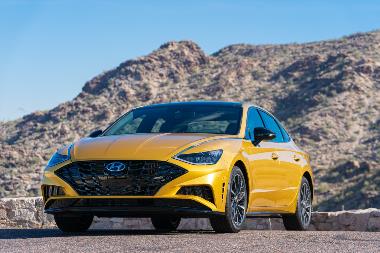
2020 Hyundai Sonata: All-new look, feel, personality and power
Tuesday, May 19, 2020
Hyundai’s Sonata began life in 1985 as a car built solely for use within Korea. It came to North America for the first time in 1988 as a second-gen …
Show MoreHyundai’s Sonata began life in 1985 as a car built solely for use within Korea. It came to North America for the first time in 1988 as a second-generation mid-size, with an Italian design by Giorgetto Giugario. Following a refreshening in 1991, Sonata replaced the Stellar as the core family sedan in the Hyundai line-up.
For 2020, Hyundai’s most enduring and most successful model begins its eighth generation following a complete redesign. According to Hyundai, the 2020 Sonata is unlike any of its predecessors, showcasing a new design philosophy, an all-new Smartstream G2.5 GDI engine and segment-first technology that can be personalized.
Hyundai’s signature product is the first sedan designed with Hyundai’s Sensuous Sportiness design language, creating a fully transformed vehicle empowered with a sporty four-door-coupe look that focuses on delivering emotional value using proportion, styling and technology. From the front, the 2020 Sonata is all-new, with cues that don’t immediately appear Hyundai-like.
In addition to its design change, new for 2020 Sonata are vehicle platform improvements in safety, efficiency and driving performance; Sonata’s Digital Key, a Hyundai first that allows the vehicle to be unlocked, started and driven without a physical key, via a smartphone; and hidden lighting lamps that turn chrome when off and lit when on. The new Sonata also uses an extensive application of advanced technologies to boost comfort, convenience and active safety. It is also the first model to premiere a new collaboration with Bose® to deliver an upscale audio experience.
Sonata’s new look blends two sharp character lines, and concave and convex forms are carefully orchestrated to provide a sexy, coupe-like character. A newly designed Digital Pulse Cascading Grille spans the front, finishing at the innermost points of new combination headlamps that feature a distinctive and innovative new lighting architecture. At the rear, a wide horizontal line extends across the center of the trunk, stretching to the edges of the car.
About 2 inches longer and an inch lower than last year, the new Sonata is more stable and confident, standing 192.9 inches long, 73.2 inches wide and 56.9 inches high on a 111.8-inch wheelbase.
From a power perspective, the light, (from 3120 lbs to 3336 depending on trim and engine), Sonata performs well with small-block engine choices. The base engine is a 2.5-liter 191-hp engine that shows a 6-hp gain over last year’s 185-hp 2.4-liter. Torque is up 3 lb-ft at 181 lb-ft, and fuel economy gains an estimated 4 mpg at 32mpg/combined, 28/city, 38/highway. On the SEL Plus and Limited trims, a 1.6 liter turbo is offered, that produces 180hp and 195 lb-ft. and fuel estimates of 31/combined, 27/city and 36/highway. Both engines are in FWD configuration and linked to an 8-speed automatic transmission. My tests in the 2.5 averaged 31.1mpg in mixed-use tests.
Performance was confident, and I was able to put down a zero to 60mph sprint in 8-seconds flat (hand-timed) seconds with a best quarter-mile of 16-flat (hand-timed).
While the engine was loud and produced in-cabin vibration and sound, the ride was smooth, the handling true and the overall experience was relatively luxurious.
Suspension is meant more for passengers than the driver, as some drivers like the feel of road nuances, and the Sonata ride was pampering, as the MacPherson strut front suspension with coil springs and the multi-link independent rear take most irregularities out of the road surfaces. Column-Mounted Motor Driven Power Steering was attentive and predictable, with only slight understeer.
In the lush cabin, bathed in ambient mood lighting enhanced by a rich, modern instrument panel, and driver/passenger comforts and environmental and entertainment amenities, Sonata is generous except for tight rear headroom. The cabin provides 40 inches of front headroom with 37.8 in the second row; 46.1 inches of front leg room with 34.8 inches in row two; and shoulder room of 57.9 up front and 56.1 behind.
Hyundai has made safety features a priority with this new generation, and the 2020 Sonata earned a five-star top rating from the National Highway Traffic Safety Administration and was named a Top Safety Pick by the Insurance Institute for Highway Safety. Hyundai's SmartSense package of driver-assistance features is standard, and includes forward-collision avoidance, lane-keeping assist, automatic high-beam assist, adaptive cruise control, and a driver-attention warning that can sense drowsy or distracted driving. The new Sonata maximizes occupant safety throughout, from a comprehensive nine-airbag set-up to a range of active and passive safety technologies.
The 2020 Hyundai Sonata is available in several packages from entry-level to packed. The midsize sedan starts at $23,600 in SE trim, $25,700 for the SEL, $27,650 for SEL Plus and $33,500 for the top-of-the-line Limited trim. My test SEL was nicely accessorized, and added the Convenience Package for $1200, furnishing a 12.3-inch LCD instrument cluster, Hyundai Digital Key, Wireless device charging, auto-dimming rearview mirror with HomeLink®, leather-wrapped steering wheel and more. A Panoramic Sunroof added $1000, mudguards were $115, exterior color options added $300, and freight added $995 for a sticker-as-tested of $29,290, but retail bonus cash programs of up to $1500 might be available, and $500 Military and First Responders programs may be available, so check with your dealer.
> Visit www.CarlisleEvents.com for more on the automotive hobby.
Mike Blake, former editor of KIT CAR magazine, joined Carlisle Events as senior automotive journalist in 2004. He's been a "car guy" since the 1960s and has been writing professionally for about 30 years. </I>
-
Carlisle Events Announces Special Offers for Customers in 2020 and Beyond
Thursday, May 14, 2020
To date in 2020, Carlisle Events has produced two events, while Carlisle Auctions has hosted one auction. Those events happened in January an …
Show MoreTo date in 2020, Carlisle Events has produced two events, while Carlisle Auctions has hosted one auction. Those events happened in January and February, respectively. Since then, the world has changed quite a bit due to COVID-19 and as such, for the first time in Carlisle Events history, car shows have been rescheduled with one (Summer Sale Auction) being canceled.
As the economy, businesses and more specifically car shows look to re-open, Carlisle Events has implemented social distancing measures and recommendations for its guests for at least the 2020 season, while also crafting special offers for customers that are valid for 2020 and carry over to 2021.
Planned special offers are effective NOW through the MONDAY of each event and include the following:
- By phone or online and in ADVANCE ONLY, customers who purchase single day or weekend spectator tickets or the ticket and parking package will be eligible for added DISCOUNT savings.This covers any Carlisle based show for 2020.Those looking to attend can do so as a non-car showing spectator at 25% off listed online ticket pricing.Again, discounts are available in advance by phone or online at CarlisleTickets.com only.A nominal $1 processing fee applies for online orders, but this isn’t just 25% off what a guest would pay for a ticket at the gate, it’s 25% off an already discounted online price point. Full price applies at the gate. Online discounts are no longer valid beginning Monday of a show week for your particular show.
- The season pass, which is valid for all Carlisle promoted events (including those in Florida) will revert to its Holiday Sale price of $71.99 ($69.99 for AACA members) now through the end of the season.In addition, it will include access to events in 2021 spanning January through May.This covers Auto Mania in Allentown, Pennsylvania, Winter AutoFest in Lakeland, Florida, Spring Carlisle, the Spring Carlisle Auction and the Carlisle Import & Performance Nationals.Season passes can be purchased by calling the Carlisle Events offices or online at Store.CarlisleEvents.com.
- The aforementioned forms of access will also have a stand-alone no touch point of entry.That means for anyone who has purchased a spectator ticket in advance or comes with a season pass in hand, they’ll be able to park and head on grounds in a convenient and streamlined manner.
- A NEW Gate-N-Go discount will be implemented for 2020. This discount historically is offered at 20% during the Holiday Sale and 10% through one month prior to the event. The one-month prior deadline remains, but between now and the deadline, Showfield/Fun Field Flash Sales will pop up online and on social media, giving guests a chance to register for 20% off the standard rate.
- Vendors, many of whom attend multiple shows at Carlisle and beyond, will be offered an incentive too.This updated vendor space renewal discount will be available to all vendors renewing during the event.Call 717-243-7855 to learn more.
In addition, for all events on the schedule (including auctions), Carlisle Events/Carlisle Auctions will be proactive from a health, sanitation and social distancing standpoint within the Carlisle PA Fairgrounds and Carlisle Expo Center. Measures are currently being finalized and when complete, will be outlined on CarlisleEvents.com and CarlisleAuctions.com. In the meanwhile, for the latest CDC guidelines, visit CDC.gov.
Visit Carlisle Events online today or call 717-243-7855 for details on the upcoming season, links to register, purchase tickets and more.
-
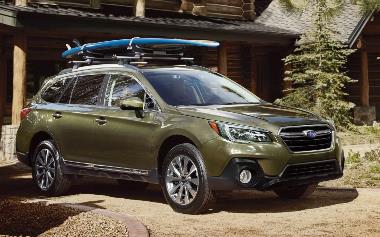
2020 Subaru Outback: New-Generation SUV-Wagon Quick, Stylish and Loaded
Tuesday, May 12, 2020
Subaru’s Outback crossover enters its sixth generation with an all-new model, its first redesign since 2015. Never seen as a rugged SUV, and fittin …
Show MoreSubaru’s Outback crossover enters its sixth generation with an all-new model, its first redesign since 2015. Never seen as a rugged SUV, and fitting in more as an SUV/Wagon vehicle the 2020 Outback is marketed as durable, versatile, stylish and robust.
Powering up for 2020, Outback offers a 2.4-liter turbocharged BOXER engine standard on XT trim models, balanced by a bevy of safety measures. Also onboard for 2020, are a new Hands-Free Power Gate, Tablet-style high-definition SUBARU STARLINK 11.6-inch touchscreen, standard EyeSight Driver Assist Technology with Advanced Adaptive Cruise Control with new Lane Centering function, and the debut of the Onyx Edition XT trim level with unique exterior and interior.
And Outback is loaded. My test Outback XT Limited was outfitted with the turbo engine, automatic transmission, symmetrical all-wheel drive, leather-trimmed upholstery, power tilt/sliding moonroof, SUBARU STARLINK® Multimedia, dual-zone climate control, 18-inch alloy wheels, electric power-assisted steering, 4-wheel independent raised suspension, brake assist, LED responsive steering headlights, LED fog lights, body-color folding side mirrors with integrated turn signals, power adjustable driver and front-passenger seats, leather-wrapped heated steering wheel, Keyless Access with Push-Button Start and PIN-Code Access, Harman Kardon premium audio system with 4G LTE Wi-Fi capability and much more.
The all-new Outback is built at Subaru of Indiana Automotive in Lafayette, Indiana on the Subaru Global Platform, with a fresh look and stronger structure that is 70-percent stiffer in both torsional and front-suspension rigidity and 100-percent stiffer in both front lateral flexural and rear subframe rigidity compared to the previous Outback’s platform. Crash protection is improved, as the new body absorbs over 40-percent more energy in front/side crashes than the current model.
Outback projects a large presence from thicker profile panel surfaces and raised rear gate as well as a sense of speed from its dynamic silhouette. Wider fenders, large hexagonal grille, front cladding and LED fog lights on the corners emphasize Outback’s capability. Side cladding, meant to resemble a hiking boot, further enhances this concept.
The new Outback is slightly larger than last year, gaining 1.4 inches in length to 191.3 inches; gaining 0.6 inches in width to 73.0 inches; remaining at 66.1 inches in height and keeping its 108.1-inch wheelbase. Ground clearance remains 8.7 inches and the Outback gains about 10 lbs. with a curbweight ranging from 3634 pounds to 3772 for the base models depending on trim. The XT models go from 3884 lbs. to 3937 lbs.The interior design uses a widened windshield and long lines from the center of the instrument panel to the door panels to create an open environment. The Outback Touring leverages luxurious appointments inside and out, including Nappa leather, high-gloss black molding for the pillars, chrome plating decorated door handles and satin tone plated side mirrors.
Comfortable inside with seating for five, interior sightlines are unimpeded, and roominess abounds, though headroom has tightened a bit to 40.1 inches in front (diminished by 0.7 inches), and 39.1 inches for passengers in row two; 42.8 inches of first-row legroom and 39.5 inches for second-row passengers, and shoulder room of 58.1 and 57.4. Cargo volume is 75.7 cu.ft. with seats folded .The Outback line-up offers two engine choices. For the first time since 2009, the Outback lineup offers a turbocharged engine, the 2.4-liter turbocharged BOXER engine, standard on XT trim models. It delivers robust all-around performance with 260 horsepower and 277 lb-ft of torque, with an EPA rating of 23/city, 30/hwy and 26/combined mileage. Meanwhile, the standard naturally aspirated 2.5-liter BOXER with direct injection delivers 182 hp and 176 lb-ft of torque, for an EPA estimate of 26/33/29. My test ride, the Outback XT Limited, sported the turbo, and I averaged 24.9mpg during my pedal-mashing tests.
Paired with a Lineartronic CVT featuring an 8-speed manual mode function with steering wheel paddle shifters, my Outback accelerated responsively and smooth for the niche, and passing at speed is predictable. From a stop, my test Outback XT Limited completed a niche-quick zero-to-60mph dash in 6.4 seconds during a 14.8-second quarter-mile.
Outback has been a crash safety and passive safety leader for years and that level is reached again for 2020. Outback is equipped with the EyeSight® Driver-Assist Technology crash prevention system, High Beam Assist, DriverFocus™ Distraction Mitigation System, Blind-Spot Detection with Lane Change Assist and Rear Cross-Traffic Alert, Reverse Automatic Braking, Traction Control, Brake Assist, Brake Override System, RearVision Camera, Subaru advanced frontal airbag system , side curtain airbags, seat-mounted front side impact bags, front passenger seat cushion airbag, driver’s knee airbag and lots more.
The base 2020 Outback with the 2.5-liter Boxer engine is priced at $26,645 and runs through four trims, topping at the Touring at $37,345. The XT version with the 2.4-liter turbo has three trims: the Onyx Edition XT ($34,895), Limited XT ($37,745) and Touring XT ($39,645). My test Outback XT Limited in Autumn Green Metallic, with a Slate Black Leather interior, and as mentioned above, the XT Limited is loaded, so much so that no optional packages are offered. Other options were available, but all my test ride added was a Moonroof Air Deflector for $99.99, Remote Engine Starter for $463, Body Side Molding for $292, Door Edge Guards for $168 and splash guards for $172. With destination and delivery charges of $1010, the sticker-as-tested was $39,949.
> Visit www.CarlisleEvents.com for more on the automotive hobby.
Mike Blake, former editor of KIT CAR magazine, joined Carlisle Events as senior automotive journalist in 2004. He's been a "car guy" since the 1960s and has been writing professionally for about 30 years. </I>
-
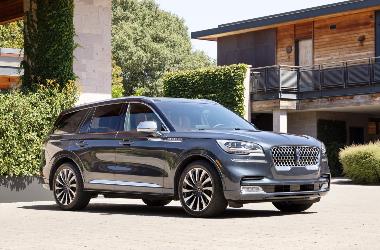
2020 Lincoln Aviator: All-New Mid-Size SUV Brings Luxury, Power and a Plug-in to the Game
Tuesday, May 5, 2020
Originally produced from 2003 through 2005 as a rebadged version of the Mercury Mountaineer, the Lincoln Aviator is back for its second generation …
Show MoreOriginally produced from 2003 through 2005 as a rebadged version of the Mercury Mountaineer, the Lincoln Aviator is back for its second generation as a mid-size five-door, three row luxury SUV.
The all-new Aviator is based on the Ford Explorer but this is more than a rebadge. Aviator has its own upscale styling, sculpting, engine, chassis makeup and tech. In addition, its attention to luxury sets Aviator apart from any of its kin.
The all-new 2020 Lincoln Aviator is missioned with combining beauty, performance and advanced technology, and debuting an electrified hybrid system. With a gas-powered 400hp /415 lb-ft of torque engine and a plug-in hybrid system that provides 494hp and best-in-class 630 combined lb-ft of torque, Aviator is built for power and capability joining with sleek elegance and intuitive technology.
Delivering what Lincoln calls “Quiet Flight,” Aviator offers those two powertrains – a standard twin-turbocharged 3.0-liter V6 gas engine and the Grand Touring’s hybrid powertrain. This marks the first time Lincoln has combined a twin-turbocharged 3.0-liter V6 engine and advanced electrified hybrid technology capable of delivering smooth performance and quick-acting torque.
On the outside, Lincoln plays off the Aviator name with a look, marketed with a sky-driven approach: “The boundless allure of flight has long inspired automotive design, and the exterior styling of the all-new Lincoln Aviator takes that inspiration to the next level. The connotations of flight are intrinsic in the strong front and tapering rear of the vehicle, creating a distinct aerofoil analogy,” according to Lincoln’s pitch. Exterior dimensions are 199.3 inches in length, a wind-attracting 69.6 inches in height and 82.3 inches in width on a 119.1-inch wheelbase, for a curb weight of from 4774 to 5673 lbs. depending on trim level and configuration. My Reserve trim weighed about 5000 lbs.
Inside, Aviator is packed with luxury appointments and comfort, a 14-speaker audio system with voice-activated touch-screen navigation system, three rows of seating, available concert hall sound, intuitive tech and function and a quiet environment of quality. Spacewise, you get 41 inches of front headroom (40.2 with a Vista Roof), 39.7 inches in row two and a tight 36.9 inches in row three. Aviator provides 43 inches of front legroom, with 40.1 in the middle and a child-only 29.2 inches in the rear seats; and 61.5 inches of front shoulder room with 61.3 in row two and 54.0 in row three.
Cabin climate is attended to by a Particulate Air Filter Tri-Zone Climate Control, with second row climate controls (with Audio and Heated/Vented Seat Controls when equipped). You also get a 10.1-inch LCD touch-screen in the center-stack, Ambient interior lighting, delayed Accessory Lighting in the first row, Lincoln Connect™ with 4G embedded modem with WiFi® hot spot capability, that enables Lincoln Way™ App remote features (when activated) and so much more we can’t do justice to listing them here.
Aviator is quiet and stable in both Front-wheel-drive and Intelligent All-wheel-drive configurations. My test Aviator Reserve in AWD was outfitted with the twin-turbocharged 3.0-liter V6 Engine with Stop-Start Technology. EPA rated at 27mpg/highway, 20mpg/city and 24mpg/combined, my short test came in at 22.1mpg. With the hybrid option, Aviator Grand Touring’s twin-turbocharged engine and advanced electrified technology lags a bit but you get impressive mileage and 20 extra miles when all-electric.
My 400hp plant was decisive, quick and seamless, and we powered through a zero-to-60mph sprint in 6-seconds-flat, during a 14.7-second (hand-timed) quarter-mile. On the highway, Aviator is quiet and steady with more than enough power to pass with nary a lag. The cushioned ride from the adaptive suspension is worthy of the price tag and Lincoln’s status as a luxury carmaker, and the 4-Wheel Disc Anti-Lock Braking System stops with authority when called upon. Aviator’s Electric Power-Assisted Steering is predictable and while there is some top-wobble during quick maneuvers, Aviator is confident in turns.
Safetywise, first, second and third row Blind Spot Detection with Cross-Traffic Alert begins the safety system, enhanced by Driver and Front Passenger Dual Stage, Side Impact, and Glove-Box-Door Integrated Knee Airbags. The Safety Canopy/Air Curtain (3-rows) with roll-over sensor adds to security as do Vehicle Inclination Sensor Remote, Keyless Entry SecuriCode™ (Keypad), SecuriLock® Passive Anti-Theft System, SOS Post-Crash Alert, Tire Pressure Monitoring System and Emergency Brake Assist Four-Way Adjustable Head Restraints.
The 2020 Lincoln Aviator is priced as a luxury vehicle, starting at $51,100 for the base Standard trim. The Reserve trim is next at $56,190, upgrading with 20-inch wheels, quad-zone climate control, optional packages including Lincoln Co-Pilot360™ Plus and more. The Aviator Grand Touring offers the rechargeable electric hybrid powertrain added to the standard Twin-Turbocharged engine, and keeps Reserve’s features, at $68,800. The top-trim Aviator Black Label starts at $77,695 with special themes, interior finishes and exclusive member service items. My Reserve in Infinite Black with an Ebony leather interior, upticked to All-Wheel-Drive for $2520, and added the $4930 Reserve 1 interior package for the Panoramic Vista Roof® with Power Sun Shade, the Elements Package and the Lincoln Co-Pilot360™ Plus Package. With Destination charges of $1095 and an Acquisition Fee of $645, my sticker came to $64,870, but available incentives of up to $800 may be available, so check with your dealer.
> Visit www.CarlisleEvents.com for more on the automotive hobby.
Mike Blake, former editor of KIT CAR magazine, joined Carlisle Events as senior automotive journalist in 2004. He's been a "car guy" since the 1960s and has been writing professionally for about 30 years. </I>
Book with a preferred Hotel

Book online or call (800) 216-1876
